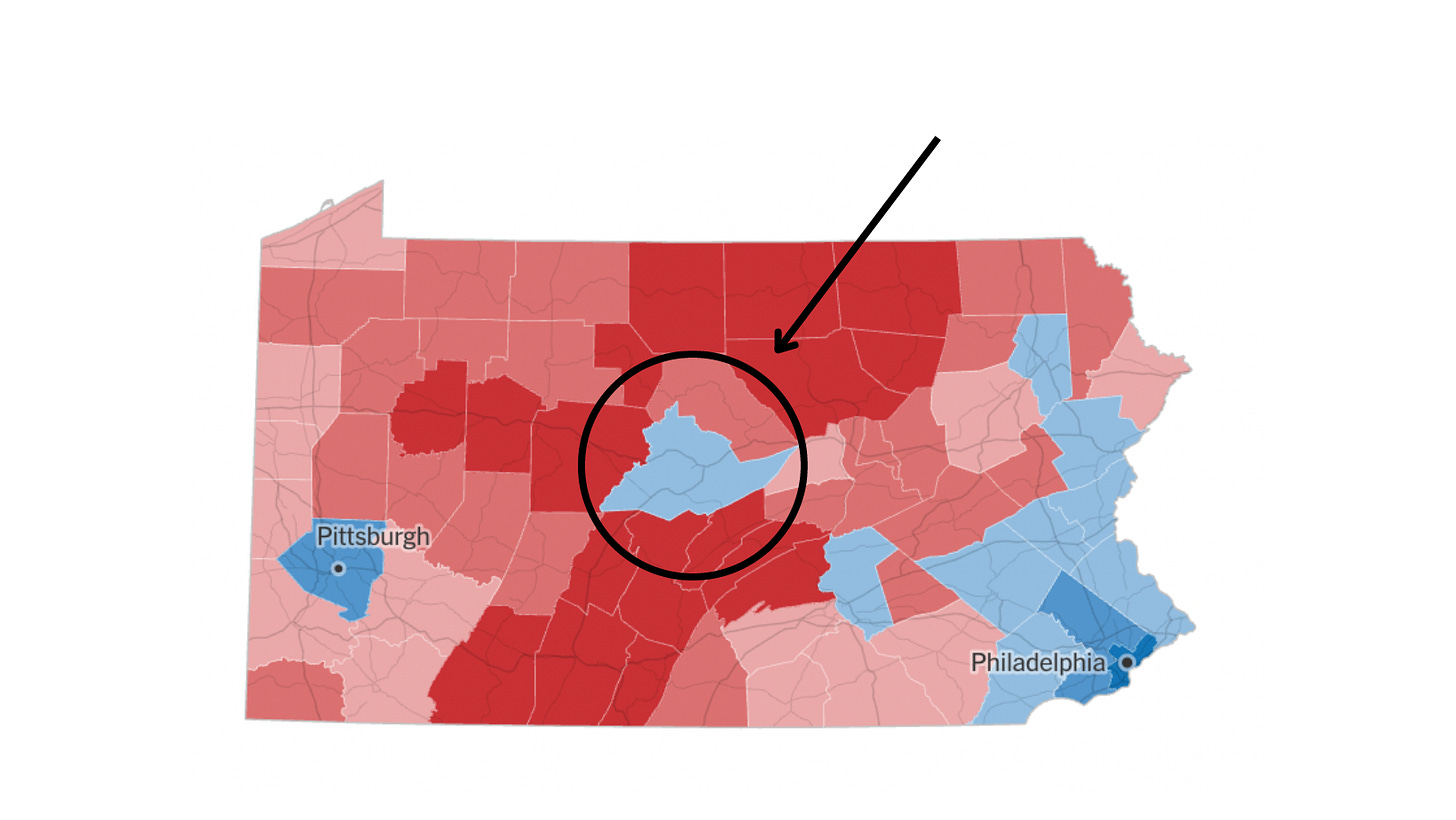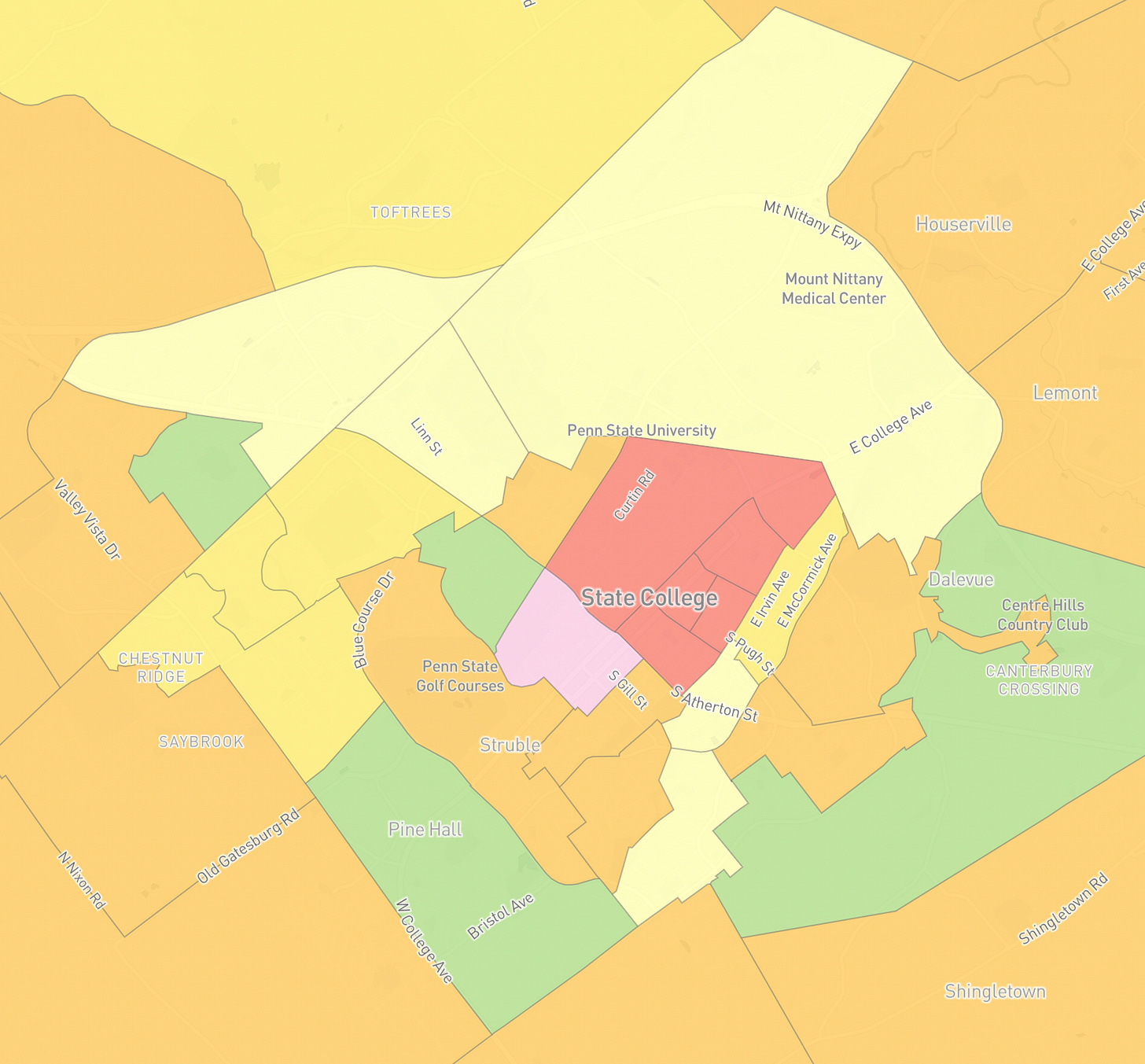Much has been discussed about college towns in Pennsylvania and how they vote, particularly when it comes to candidate performances statewide. There are a lot of them scattered around the state, such as F&M College in Lancaster, East Stroudsburg University in Monroe, and more. But today, we turn our attention to perhaps the most infamous one - Penn State in Centre County.
Year after year and election after election, Centre usually votes for Democrats by a modest tilt or lean margin, usually never overwhelmingly. It stands as a lone blue island in a sea of red, characterized on maps such as this one.
The math for Centre is relatively simple. With Penn State at its heart, as well as containing the only population center of considerable size in the county, it provides Democrats with a sturdy base of support. Because of high margins for the GOP in the outlying rurals and vice versa for Democrats in the hyper-liberal areas of State College, this county isn’t subject to the massive variations and shifts you see in some others like, say, Bucks. To win Centre, it mostly comes down to who has the better turnout along with a little bit of persuasion sprinkled in. It varies depending on the election.
Let’s take Daniel McCaffery’s recent win in this year’s Supreme Court election, for instance. If you look at the following map, it’s fairly easy to understand how Democratic fortunes work here. By maximizing margins around Penn State and its auxiliary precincts, the margins from the surrounding deep red precincts are offset thanks to the population differential. Indeed, State College itself contains over a quarter of the county’s population, let alone nearby unincorporated communities like Boalsburg and Park Forest Village.
Naturally, it’s not too hard to understand why State College is so blue. It’s full of college students, professors, support staff, and lots of other demographics that make up the current Democratic coalition. Often overlooked in more rural, less urban/suburban counties, they exist in enough numbers here to make a significant impact on Centre. Coincidentally, when we discuss why some rural counties in Pennsylvania haven’t seen the bottom fall out for Democrats, one reason is thanks to some of those smaller colleges. They’re not big enough elsewhere to flip certain areas, but they help on the margins and assist in stopping Pennsylvania rurals from voting like, say, Mississippi.
Relatedly, let’s zoom in further on State College and its surrounding precincts.
Where the deep blue precincts appear, the outlines of the housing sprawl from Penn State itself are readily apparent. They peter out once you start hitting those deep red precincts settled by voters who heavily favor the GOP. AKA older, whiter folks who tend to work on farms, state land, and/or small communities.
As for State College itself, of its overall student population, over 75% are 24 years of age and under. That pretty much tells the whole story, even as almost 80% of the people in the area are white. Supporting precincts like the ones in Park Forest Village also have high numbers of relatively young voters - 60%+ of the people there are 40 years of age and under. There are some minorities, but if you’re doing the math in your head, they’re nowhere near numerous enough to have an outsized impact. It’s young voters driving the direction of those precincts.
Truthfully, young voters are why we’re here. The nature of how and why they vote is often a source of intense public debate, especially over matters of policy and voter outreach from campaigns that consider the merits of the latter. And right here we have a county where young voters play a pretty heavy role in the electorate. But how much of an impact are they making on the margins?
After all, those margins only tell one kind of story. Raw votes are very different from precinct to precinct and can change drastically based on the margin, impacted in part by turnout levels. Let’s look at Centre 2023 again, but this time with turnout precinct-by-precinct instead of party margin.
As you’re perusing this, some noticeable things become clear. For one, the rural areas of the county had decent turnout, mostly in the 40-50% range. State College, however, is a bit of a different story. If we zoom into it (again), the turnout picture is considerably more mixed.
The area immediately enclosing Penn State itself had pretty dreadful turnout, usually less than 10%. Those red precincts are where the student dorms are located - par for the course when it comes to trying to juice turnout in those locations, especially in off years. Turnout, however, was measurably better in the surrounding precincts, which has a mix of off-campus and housing belonging to faculty, support staff, and the like. Which, mind you, are far more predisposed to vote. Not all of this is entirely the fault of students, given that many of them are transplants and are likely registered to vote back home or are temporary residents. For the ones registered to vote in Centre County, however, even turnout on that front was middling at best.
As you’re reading all of this, you’re probably asking yourself why, especially given what was discussed earlier in this article, Centre even ended up going blue in the first place. If Penn State students had garbage turnout, doesn’t that defeat the premise of what we’re seeing?
Not quite. This is where we start putting things together. As mentioned previously, while turnout was less in the State College area, it still consists of a very big chunk of the county’s population. Depending on the context, 80% turnout in, say, a rural precinct that has 80 voters looks very different from 20% turnout in a suburban precinct with 500 voters. And for the green precincts you see immediately surrounding Penn State, they had chunks of high-propensity voters. Hitting 50% turnout in precincts with ~1,000+ people is quite helpful with padding overall margins.
That alone doesn’t defeat rural margins coming in from the rest of Centre, though. Presents a bit of a conundrum, but fortunately, there is a solution. One that has proven extremely helpful for Pennsylvania Democrats in recent years. And it’s called persuasion.
You may recall that I mentioned that a bit of persuasion plays into being able to win this county. Well, this is a pretty clear demonstration of how that works. McCaffery won by a blowout margin statewide, one reason being due to convincing a lot of moderates and Republicans to vote for him. There’s a lot more to it and more to discuss about how it affected other counties, but we’re focusing on Centre for now.
For persuasion there, what played to McCaffery’s benefit is that in some of the outer rural precincts with high turnout, his margins of loss were smaller than past candidates. There were a few areas where he outran Biden and even some past PA Supreme Court nominees. That helped to compensate for terrible student turnout and allowed the State College precincts with solid turnout to seal the deal and give him a 4-point win. Although the margin map doesn’t show splits beyond 15%, there’s a big difference between losing a blood-red precinct by 30% one year and 40% in another. It adds up quickly.
Quite sufficient with no presidential race or midterm to boost turnout further, if you ask me. In fact, here’s a table showing what past margins have looked like in Centre over the last few years.
McCaffery’s win is extremely typical, especially in off-years. Certainly doesn’t indicate anything amiss of a large shift in how the county leans, especially since he ended up doing better than McLaughlin in the last PA SC race in 2021. Persuasion was a little better for him and not only got him over 50% but allowed him to slightly improve on her performance.
And there we have it. That’s your basic rundown of how college towns play a role in electorates where they’re big enough to make an impact. As fickle as the youth vote can be, it’s massively helpful in certain situations. But I can tell you this much - McCaffery wouldn’t have gotten over the finish line with just them alone. Nor would relying on the vote elsewhere have worked. We have two very opposite situations, so which is true?
The truth, as usual, lies in a little bit of both. The high turnout driven primarily by the youth (relatively speaking) and professionals outside of Penn State proper gave Democrats a high floor while a sprinkle of persuasion in the outer boroughs and rurals got them across. Variations of this combination have waxed and waned over the years, but it’s not a hard lift for Democrats to sustain. It helps that the quality of the Centre County GOP is extremely questionable, thanks to their super-online presence and adherence to right-wing principles, insulated by the dogma of being out in the middle of pretty much nowhere this far deep in Pennsylvania.
For as long as State College exists in its current demographical composition, I see little to no reason why Centre wouldn’t continue to operate in its current form. Presidental turnout is sufficient for Democrats to win it. In off years, it requires a little more in the way of persuasion to be able to do so. Which, frankly, has been an easy achievement for some time now. There have been few exceptions to this rule, the most notable one being Pat Toomey in 2016 being able to edge it out, notably helped by persuasion and a more dismal than usual showing for a presidential election.
But anyway, that’s all I have to say about that. The youth vote, in certain contexts, is worth looking at. And it still serves as a warning for Democrats who should keep the turnout dynamics of that group in mind when running campaigns. Penn State is lucky to have mid-20s and over college professionals there, or else you would be seeing a much redder Centre County today.
Until next time.










Thanks! This is spot-on. State College (especially in the townships that define the school district) is dominated by faculty and administrative staff; because of property prices, much of the clerical and other staff live in various places outside of the Borough. The student vote is always hard to gauge because of so many of the more politically aware ones being registered in their "home" locations (which in many cases aren't even in PA - PSU has a huge and growing out-of-state and international student population, and in-state students are now only about 52% of the student body at University Park). And your point about the Centre GOP is key; the parts of Centre Co. that are red are REALLY red, which means that at a sub-county level it's pretty much wacko central.